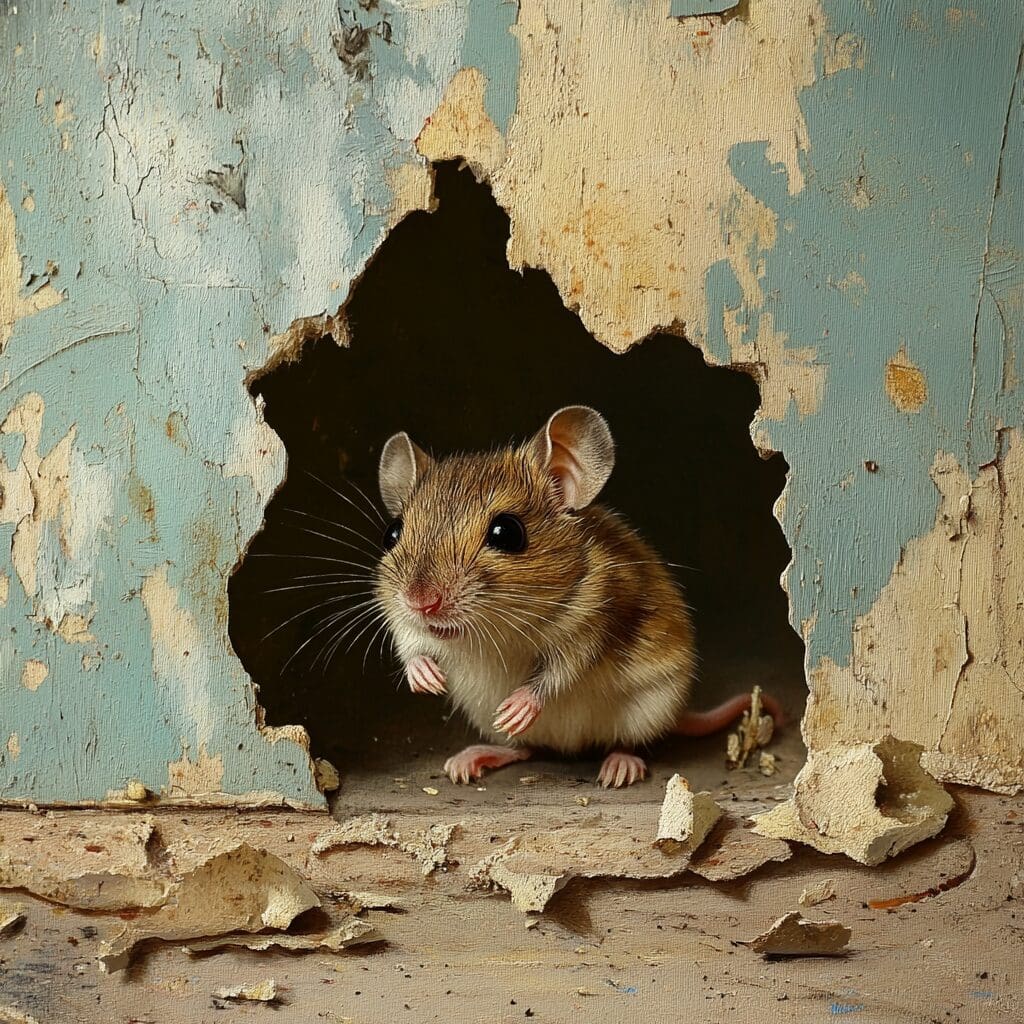
When winter arrives, you might think pests hibernate until spring - but that's far from reality. As temperatures drop, various pests actively seek warm shelter, and your cozy home becomes their prime target. These unwanted visitors don't just make themselves comfortable; they can cause significant damage to your property and pose health risks to your family.
Understanding Common Winter Pest Problems
As temperatures drop below freezing, pest problems don't disappear - they often intensify as creatures seek warmth inside homes. Here's what you need to know about the most prevalent winter pest issues:
Entry Points and Access
-
Pests enter through tiny gaps around utility lines windows doors and foundation cracks
-
Rodents can squeeze through holes as small as 1/4 inch in diameter
-
Tree branches touching rooflines create natural bridges for pests
-
Improperly sealed chimneys vents and roof edges serve as entry pathways
Common Areas of Infestation
-
Kitchens and pantries attract pests seeking food sources
-
Wall voids and attics provide warm protected nesting spaces
-
Basements and crawl spaces offer humidity and shelter
-
Bathrooms appeal to moisture-loving pests like cockroaches
Signs of Winter Pest Activity
-
Droppings especially from rodents near food storage areas
-
Gnaw marks on wood surfaces wiring and packaging
-
Unusual scratching sounds in walls or ceilings
-
Greasy rub marks along baseboards from rodent traffic
-
Musty odors particularly in enclosed spaces
Property Damage Risks
-
Chewed electrical wiring creates fire hazards
-
Damaged insulation reduces heating efficiency
-
Contaminated food items from pest activity
-
Structural weakness from carpenter ant and rodent damage
-
Rodents spread over 35 diseases through droppings urine and saliva
-
Cockroaches trigger allergies and asthma symptoms
-
Bed bugs cause itchy welts and psychological stress
-
Contaminated surfaces lead to bacterial infections
Remember that winter pest problems require immediate attention. Infestations can grow rapidly in enclosed, heated spaces. A single pair of mice can produce up to 60 offspring in one year, making early detection crucial for effective control.
Rodents: Your Unwanted Winter Housemates
As temperatures drop, rodents invade approximately 21 million homes each winter according to the National Pest Management Association. These unwanted guests seek warmth, food and shelter in your cozy indoor spaces.
Signs of Rodent Infestation
-
Fresh Droppings: Look for dark capsule-shaped droppings along walls baseboards and near food sources
-
Gnaw Marks: Check wooden surfaces electrical wiring insulation and furniture for teeth marks and shavings
-
Grease Marks: Notice dark greasy marks along walls and floorboards from rats rubbing against them
-
Nesting Materials: Watch for shredded paper fabric insulation and other soft materials gathered into makeshift nests
-
Strange Noises: Listen for scratching scurrying or squeaking sounds in walls ceilings or under floors particularly at night
-
Unusual Pet Behavior: Pay attention if your pets suddenly appear agitated or focus on specific areas of walls or floors
-
Seal Entry Points: Block all holes larger than 1/4 inch using steel wool caulk or metal sheeting
-
Remove Food Sources: Store food in airtight metal or glass containers and clean up crumbs immediately
-
Eliminate Water Sources: Fix leaky pipes promptly and remove standing water around your home
-
Maintain Yard: Keep grass short trim branches away from your house and store firewood at least 20 feet from buildings
-
Declutter Spaces: Remove cardboard boxes paper piles and unnecessary storage that rodents use for nesting
-
Regular Inspection: Check your home's exterior and interior monthly for new potential entry points
Cockroaches: The Year-Round Invaders
Unlike seasonal pests cockroaches remain active throughout winter thriving in heated homes where they find ideal conditions for survival. These resilient insects enter through tiny cracks in windows screens doors or by hitchhiking on packages.
Health Risks and Concerns
-
Spread dangerous pathogens that cause E. coli salmonella and typhoid infections
-
Trigger respiratory allergies and asthma symptoms through their presence and droppings
-
Contaminate food surfaces and personal belongings with bacteria
-
Cause urinary tract infections digestive problems and sepsis
-
Leave behind allergens that pose serious health risks especially to children and elderly
-
Seal all potential entry points including tiny cracks around windows and doors
-
Remove clutter and food waste to eliminate hiding spots and food sources
-
Keep food in airtight containers and clean spills immediately
-
Fix water leaks and reduce moisture in bathrooms and kitchens
-
Address infestations promptly as populations can grow rapidly in warmer indoor environments
-
Maintain cleanliness in food storage areas like pantries and cabinets
-
Inspect packages thoroughly before bringing them inside to prevent hitchhiking roaches
Spiders Seeking Winter Shelter
During winter months, spiders actively seek indoor shelter to escape dropping temperatures and maintain their survival. These cold-blooded creatures are drawn to the consistent warmth and humidity levels found in homes.
Common Indoor Spider Species
-
Black Widows are one of the most dangerous spider species that enter homes during winter, requiring extra caution due to their venomous nature.
-
Brown Recluses commonly invade buildings for winter shelter, preferring dark undisturbed areas like basements attics closets.
-
House Spiders establish themselves in moisture-rich areas such as bathrooms laundry rooms garages.
-
Cellar Spiders gravitate toward basements and crawl spaces where humidity levels remain high.
-
Seal Entry Points by blocking all exterior cracks and crevices to prevent spiders from accessing your home.
-
Remove Outdoor Habitats by keeping lawn and shrubbery trimmed as spiders use overgrown vegetation as staging areas.
-
Clean Regularly to eliminate existing webs immediately preventing other spiders from claiming abandoned webs.
-
Reduce Moisture in bathrooms basements and other humid areas that attract spiders seeking hydration.
-
Control Other Pests since spiders follow their food source - addressing existing insect problems will reduce spider populations.
-
Inspect Dark Areas including stored shoes boxes and rarely-used items where spiders commonly hide.
-
Maintain Exterior by checking window screens door sweeps and utility entry points for potential access routes.
Bed Bugs: Not Just a Summer Problem
Bed bugs remain active year-round and thrive in heated indoor environments. These resilient pests become particularly problematic during winter travel seasons when they can easily hitch rides in luggage and clothing.
Detection Tips
-
Look for small brown oval-shaped insects about 1/8 inch long near mattress seams beds and headboards
-
Check for tiny dark spots (bed bug excrement) on bedding sheets mattresses and nearby walls
-
Inspect baseboards electrical outlets and ceiling cracks where bed bugs commonly hide
-
Watch for small bloodstains on sheets or pillowcases from crushed bed bugs
-
Examine luggage and clothing thoroughly after traveling especially around seams and pockets
-
Wash all infested bedding and clothing in hot water (at least 120°F) and dry on high heat
-
Vacuum affected areas thoroughly including mattresses carpets and furniture
-
Seal cracks and crevices around baseboards electrical outlets and wall joints
-
Use mattress encasements to trap existing bed bugs and prevent new infestations
-
Contact professional pest control services for severe infestations as bed bugs are resistant to many DIY treatments
Ants Marching Indoors
Ants commonly invade homes during winter months seeking warmth, food and moisture. Despite popular belief, many ant species remain active throughout the cold season by adapting their survival strategies.
Winter Ant Behavior
-
Ants synthesize glycerol in their bodies to prevent freezing when temperatures drop below 15°F
-
Multiple ant species actively seek indoor shelter including Acrobat, Argentine, Carpenter, Crazy, Dark rover, Ghost, Odorous, Pharaoh and White-footed ants
-
Carpenter ants pose the greatest winter threat as they can establish colonies inside walls and wooden structures
-
Key identifying features of carpenter ants include:
-
Dark bodies
-
Narrow waists
-
Elbowed antennae
-
Front wings longer than back wings
-
Seal all exterior cracks and holes around utility lines, windows and door frames
-
Remove food sources by storing items in airtight containers
-
Clean up spills and crumbs immediately
-
Reduce moisture problems by fixing leaky pipes and faucets
-
Trim tree branches and shrubs away from your home's exterior
-
Keep firewood stacked at least 20 feet from the house
-
Inspect packages and boxes before bringing them inside
-
Remove standing water near foundation
-
Maintain proper ventilation in crawl spaces and attics
-
Schedule regular pest inspections, especially if you spot carpenter ants during winter
Cluster Flies and Winter Moths
These common winter pests create unique challenges for homeowners seeking warmth during colder months.
Identifying the Pests
-
Cluster Flies: Look for blackish-silver insects with overlapped wings moving sluggishly near windows or in attics. They often gather in groups forming visible clusters especially on warm winter days.
-
Size and Appearance: Cluster flies measure about 16 inches long weighing 7 to 18 ounces. They're distinguished by their slow movement and tendency to group together.
-
Activity Patterns: You'll notice increased activity during mild winter days when indoor warmth disrupts their hibernation causing them to fly toward windows and light sources.
-
Foundation Gaps: Check and seal all cracks in your home's foundation where these pests commonly enter.
-
Window Protection: Install or repair window screens and seal gaps around window frames as these are primary entry points for both cluster flies and winter moths.
-
Ventilation Areas: Cover vents pipes and chimneys with appropriate mesh screens to prevent pest entry while maintaining proper ventilation.
-
Door Maintenance: Install door sweeps and weather stripping to close gaps under and around doors.
-
Proactive Inspection: Regularly examine your home's exterior for new gaps or cracks especially before winter arrives.
-
Professional Sealing: Consider professional pest control services for thorough inspection and sealing of hard-to-reach entry points especially in attics and high areas.
Silverfish in Damp Areas
Silverfish thrive in damp environments and can quickly establish large populations in your home during winter months. These moisture-loving pests seek warmth and humidity in bathrooms basements and other humid areas.
Damage Assessment
-
Books papers and photographs face significant risk from silverfish feeding which leaves irregular holes and yellow stains.
-
Wallpaper adhesive and clothing particularly items containing natural fibers like cotton silk or linen can sustain severe damage.
-
Food packages in pantries often show signs of silverfish activity through small holes and contamination.
-
Important documents and precious family photos stored in damp areas become prime targets for these pests.
-
Cardboard boxes and storage containers may harbor silverfish leading to damaged contents.
-
Install dehumidifiers in basements bathrooms and other damp spaces to maintain humidity levels below 50%.
-
Fix leaking pipes faucets and drainage issues immediately to eliminate moisture sources.
-
Use exhaust fans in bathrooms and kitchens during showers and cooking to reduce ambient moisture.
-
Seal gaps around pipes and utility lines with appropriate materials to prevent water seepage.
-
Store valuable items in airtight plastic containers rather than cardboard boxes.
-
Keep storage areas well-ventilated using fans or opening windows periodically.
-
Remove old newspapers magazines and cardboard from damp areas to eliminate silverfish food sources.
-
Apply weatherstripping around windows and doors to prevent moisture from seeping inside.
Overwintering Stink Bugs
Stink bugs become a significant winter pest problem as they seek warm shelter during cold months. These garden pests typically begin their invasion in fall when temperatures drop searching for protected overwintering sites.
Common Hiding Places
-
Outdoor Areas: Stink bugs frequently gather in large dead trees with a circumference over 23 inches particularly oak and locust trees with porous dead tissue and peeling bark
-
Building Exteriors: They congregate on the sunniest warmer areas of house exteriors before finding entry points
-
Indoor Spaces: Once inside they settle in:
-
Attics (especially unheated ones)
-
Wall voids
-
Crawl spaces
-
Ceiling cavities
-
HVAC units
-
Garages
-
Gas grills
-
Vehicle storage areas
-
Preventive Measures:
-
Seal gaps around building foundations
-
Install screens on windows doors and vents
-
Control tree infestations before fall migration
-
Remove female boxelder trees from your property
-
Create preventative exterior barrier treatments
-
Active Control:
-
Focus treatment on sunny exterior walls where stink bugs gather
-
Address entry points around:
-
Utility penetrations
-
Window frames
-
Door frames
-
Foundation cracks
Boxelder Bugs on Sunny Days
Boxelder bugs emerge from their winter hiding spots during sunny winter days seeking warmth on south-facing walls.
Seasonal Patterns
-
Congregate in large numbers on exterior walls during late fall preparing for winter
-
Squeeze through tiny cracks around windows doors & foundations to enter homes
-
Become active on sunny winter days even when outdoor temperatures are cold
-
Cluster near windows & sunny spots inside homes seeking warmth
-
Return to outdoor hibernation sites when spring temperatures rise
-
Seal cracks & gaps in foundation walls with silicone caulk
-
Install weather stripping around windows & doors
-
Cover vents & chimneys with fine mesh screens
-
Remove boxelder trees within 100 feet of buildings
-
Repair torn window screens & door sweeps
-
Vacuum visible bugs instead of crushing them to avoid stains
-
Apply insecticidal soap to exterior gathering spots
-
Contact pest control for severe infestations requiring targeted treatment
Creating a Winter Pest Prevention Plan
Don't let winter pests turn your cozy home into a seasonal retreat. By staying vigilant and implementing proper prevention strategies, you'll protect your living space from unwanted guests throughout the cold months.
Remember that pest control isn't a one-time solution but an ongoing process. Your best defense is a proactive approach that combines regular inspections, thorough sealing, and proper maintenance. If you spot signs of pest activity, don't hesitate to contact a professional pest control service.
We hope you enjoy these informational articles. If you'd like to learn more about our eco-friendly pest control services, call (844) 955-2447.
Read More
Your Path to a Pest-Free Home or Business
Romex Pest Control
We are committed to protecting you, your children, and your pets with our eco-friendly, child-friendly, and pet-friendly guaranteed pest control solutions.
Romex Pest Control is fully insured and licensed in Texas, Oklahoma, Louisiana, and Mississippi.
Hours
M-F 8 am–5 pm
Sat 8 am–2 pm
Sun Closed
Established 2016 © Copyright 2025 Romex Pest Control










